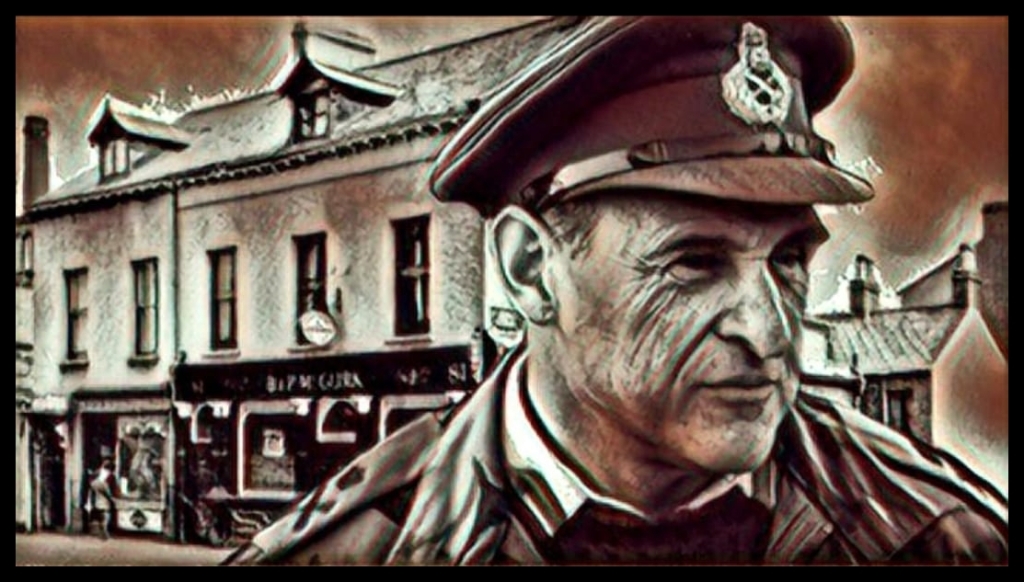New evidence has emerged about the UVF’s bombing of McGurk’s Bar in Belfast in December 1971.
The explosion caused the entire structure of the premises to collapse, killing fifteen Catholic civilians – including two children – and wounding seventeen more. It was the deadliest attack in Belfast during the Troubles.
Brigadier (later General Sir) Frank Kitson commanded the British Army in Belfast 1970-72. He was a counter-insurgency guru who created havoc on the island before he was drummed out of it by William Whitelaw, the first British secretary of state for Northern Ireland. One of the conscious choices Kitson made while still in Ireland was to take on the IRA but not Loyalist terrorist gangs such as the UVF. This coincided neatly with the policy of the British government of Edward Heath which decided to intern members of the IRA but not Loyalist paramilitaries. On these grounds alone, the British state became indirectly responsible – through inaction – for the crimes of the UVF, including the McGurk tragedy.
Worse still, there are indications that Kitson may have exploited elements of the UVF as a proxy assassination apparatus for the British state in Belfast.
1. Redaction of Evidence
The sliver of new information about the massacre was recorded in a log by the 2nd Battalion Royal Regiment of Fusiliers (2RRF) approximately forty-two minutes after the bombing. It relates to the proprietor of the bar, Patrick McGurk, and the nearby Gem Bar.
Britain’s Information Commissioner’s Office has upheld a decision by Britain’s National Archives to withhold a section of the log from the families of the victims of the massacre. The Archive acted in consultation with the British Ministry of Defence (MoD).
The 2RRF log reveals:
Owner of pub a moderate RC [Roman Catholic] unlikely to have allowed people to use it as a mtg [meeting] place. Bar close to Gem Bar which is a [REDACTED].
2. The Gem Bar
The information relating to the Gem Bar remains withheld even though the venue no longer exists.
When they were making their case for a full declassification of the log, the families of the victims of the attack presented archival evidence to the Information Commissioner’s Office that the Gem Bar was:
- The original target of the bombers;
- Known as an Official IRA bar;
- Recorded in British Army files as the local HQ of the Official IRA;
- Under British Army surveillance;
- And that the premises had been targeted by 2 RRF two nights before the bombing during which 2 RRF arrested and questioned six customers from the Gem Bar raid.
Put simply, the perceived connections between the Gem and the Official IRA was a known fact and therefore any information pointing in that direction was not going to endanger anyone, especially as the pub has long since closed. Moreover, former known members of both wings of the IRA walk about Belfast without any concern for their safety. Some of them have published books about their paramilitary careers, others have been interviewed on the record by the press, radio and TV
Despite this reality, the log remains redacted.
3. Reaction of the families
Ciarán MacAirt is a grandson of two of the victims of the McGurk’s Bar Massacre and has been fighting for sight of the information – all of it – for five years. He said:
After 50 long years fighting the British state’s lies, our families are outraged but unsurprised that it is withholding evidence relating to the mass murder of our loved ones in McGurk’s Bar. The British state has lied to us from the moment the bomb exploded up to this very day.
Police Service Northern Ireland and the Office of the Police Ombudsman either failed to find this evidence or found it and buried it again as it has been left to the families to expose the truth about the McGurk’s Bar Massacre and its cover-up by the British state.
Nevertheless, even when we discover new evidence, the British authorities withhold it from us and deny us access to the truth. In the meantime, many of our older family members are infirm or have gone to their graves without any justice.
A video about the attack can be accessed here: https://www.youtube.com/watch?v=uQRLFnBxoWQ

4. The shape of an extremely disturbing state of affairs.
The redaction is deeply disturbing. There is no good explanation for it. Why do the MoD censors want the redacted words withheld from public scrutiny, even after more than fifty years?
The shape of an extremely disturbing state of affairs involving dirty tricks, collusive murder and black propaganda is swimming into focus.
The following scenario is one that offers an explanation for what happened in 1971, and why the British State still feels it necessary to redact the document.
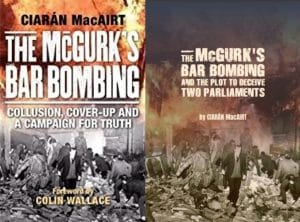
5. Kitson and the IRD
Brigadier Frank Kitson was involved in a black propaganda operation that swung into action shortly after the bombing. He was almost certainly aided and abetted by Hugh Mooney who worked for the Information Research Department (IRD) of the Foreign Office. Mooney had been sent to Belfast to destabilise the IRA through the deployment of psychological operations (PsyOps).
Kitson, who commanded the British Army in Belfast and its environs, was a meticulous planner who became deeply engaged in propaganda operations during his two years in Belfast. He was also the British army’s foremost counterinsurgency expert having honed and developed his skills in Kenya, Malaya, Oman and Cyprus. His infamous treatise about counterinsurgency, ‘Low Intensity Operations’ was published in 1971.

One of the hallmarks of Kitson and Hugh Mooney was the meticulous manner in which they planned their operations in Ireland, invariably well in advance of their deployment.
The black propaganda operation that swung into action after the bombing of McGurk’s Bar was up and running a little over four hours after the attack. The operation was a sophisticated affair, one that involved the coordination of senior British Army officers (including Kitson and his superior Lt. General Sir Harold Tuzo, General Officer Commanding Northern Ireland), the British Army’s bomb squad, and the PR departments of the RUC and British Army. It is inconceivable that they managed to meet up late at night and agreed to implement an off-the-cuff fake news operation to assist a UVF gang that had just slaughtered fifteen people for no good reason. At some point they must have ordered the forensic bomb examination unit to go along with the lie. Only someone as senior as Kitson could have issued such a draconian command.
6. Kitson and the MRF
The attack which destroyed McGurk’s Bar took place after Kitson’s Military Reaction Force (MRF) had been deployed in Belfast. In its earliest guise, the MRF was known as the ‘Bomb Squad’. The MRF had many responsibilities.

One task was to monitor the bomb attacks which were taking place in Belfast.
Another was the deployment of plain clothes officers – some of whom dressed as drunks and tramps – to penetrate Nationalist areas where they gathered intelligence on the IRA.
Yet another of its assignments was assassination.
Assassination was a speciality of Brigadier Kitson. It was he who initiated collusion between Britain’s special forces and Loyalist murder gangs. One of his agents was Albert Ginger Baker, codenamed ‘Broccoli” who penetrated the UDA at the highest level by becoming a bodyguard to the Inner Council of the UDA. Baker murdered a string of innocent people in Belfast while in the UDA. He is still alive. Kitson and the MoD are being sued by the family of one of Baker’s victims.
British special force cooperation also extended to the UVF.

It is apparent from Kitson’s book, ‘Low Intensity Operations’ that he felt the enemy in Ireland was to be found among the Catholic/Nationalist community. He wrote that “in the historical context it may be of interest to recall that when the regular army was first raised in the 17th century, ‘Suppression of the Irish’ was coupled with ‘Defence of the Protestant Religion’ as one of the two main reasons for its existence”. This book was published in 1971, the same year as the bombing of McGurk’s.
Kitson was not squeamish about collateral damage, especially where it involved communities which harboured – as he perceived it – terrorists in their midst. He was an advocate of the Maoist dictum that the relationship between insurgents and the population supporting them was akin to that between a fish and water. He later propounded that if a ‘fish has got to be destroyed it can be attacked directly by rod or net … But if rod and net cannot succeed by themselves it may be necessary to do something to the water …” This could even include “polluting the water”. In other words, non-combatant members of a community caught up in a conflict could become fair game for strong-arm tactics.

A young Kitson. He became indifferent to the death and suffering of others. A racists, he described Kenyans as “half breeds” and “dangerous wild” animals.He had long since become indifferent to death and suffering. Kitson experienced no difficulty operating in the grotesque hell that Kenya had become. After dinner one night a colleague said he wanted to have a quick look in the Tigoni mortuary because he was missing an informer who might have found his way in there. “The shambles inside was past all describing”, he wrote in a book published in 1960. There “must have been eighteen bodies in a place the size of a small summer house … Some of them had been there for five days and were partially decomposed. They were all lying around tangled up on the floor as there were no slabs in the Tigoni charnel house.” His colleague behaved as though nothing was wrong and “continued talking about whatever it was we had been discussing before we got there, as he rummaged around in the human wreckage. After a few moments while I looked out through the door I forced myself to look back inside again. In a surprisingly short time I found that I was no longer bothered by the sight. But for the smell, I might even have been looking at a lot of old bicycles lying on the ground … Now I had seen something more revolting than I could have imagined – even the cinema could not have produced such a spectacle – and I had found that I hardly minded at all. From that time on I felt more sure of myself.”
In a more infamous quote, he wrote in 1977 that most British soldiers in Kenya “saw evidence of revolting Mau-Mau brutality from time to time, and probably regarded the finding and disposing of gang members in the same way as they would regard the hunting of a dangerous wild animal”.
7. An explanation that attempts to make some sense of the bombing despite all the lies.
The picture that begins to emerge about the massscre is of a Kitson sponsored bomb attack which went astray. The original plot was to wipe out the patrons of the Gem Bar who were suspected of being members of the Official IRA.
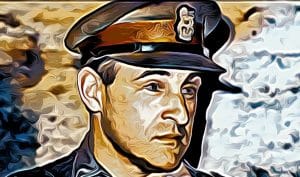
The first obstacle that would have faced Kitson in this scenario was that an attack by the UVF, particularly one of this magnitude, would have sparked a clamour for the internment of the UVF. At the time, the policy of the British government was to sweep up Nationalists but not Loyalists for internment. Hence, the attack on the Gem Bar could not be presented to the public as one perpetrated by the UVF. It could, however, be presented the media as an IRA ‘own goal’. In other words, the UVF could have brought the bomb to the Gem Bar safe in the knowledge that Kitson, Mooney and the black propaganda specialists would ensure that the media would report the attack as an IRA “own goal “. The nature of the own goal in these fabricated circumstances was one involving an alleged IRA unit making an imaginary rendezvous at the Gem Bar with the bomb in a holdall with the intention of transporting it to a target elsewhere, but that it exploded prematurely due to a fault with its timing device.
It is more than likely that the MRF was deeply involved in the monitoring of the Gem Bar. British Army logs prove that the MRF was attached and reported to 2RRF. The redacted log the subject matter of this article, was a 2RRF document.
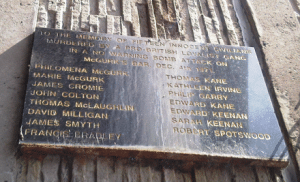
The 2RFF was deployed from October 1971 to February 1972 in the New Lodge, Unity and City Centre areas of North Belfast. Documents have emerged which show that the MRF was operating covertly with 2RRF in the vicinity of McGurk’s on the day and night before the bombing.
The MRF disappears from the logs on the day of the attack. That only makes sense if someone altered the logs or if the entire MRF unit took the day off. The worst case scenario is that the MRF was acting in league with one or more of the UVF murder gang.
8. The target of the attack switches from the Gem to McGurks
The possible scheme that is considered here appears to have begun to fall apart because there were two men – possibly security guards – outside the Gem on the night of the attack.
It is known that the UVF gang consisted of three men who waited outside the premises in a car for a while in the hope that the men would disappear.
Eventually, the UVF gang gave up and took the bomb to McGurks. Unlike the Gem, there were no men outside McGurk’s. The gang lit the fuse and left the bomb outside the building.

All the propaganda about the Gem Bar now switched to McGurk’s.
First, McGurk’s became something it was not: an alleged haunt of the IRA, at least according to Kitson and his IRD accomplices.
Second, the bomb was portrayed as having exploded inside the premises rather than outside it. There is indisputable proof that Kitson knew that the bomb detonated outside the premises. This was established by the forensic team which performed a preliminary inspection of the bomb site that night and confirmed this the following morning with the benefit of better light. The entire building was demolished during the explosion. A crater outside the building was identified as the source of the detonation.
The evidence that the bomb exploded outside McGurk’s was suppressed and replaced with the black propaganda that the device exploded inside. The RUC and British Army were responsible for disseminating this untruth.

Third, the bomb was portrayed as one which had exploded due to a timing error. This flew in the face of the truth for the explosion was the result of a lit fuse. The sparkling fuse was seen by a young boy who warned a man who was walking towards the pub to keep away from it. The black propagandists made the sparkling fuse disappear thereby implying that the bomb was one controlled by a timer. Suffice it to say that in these invented circumstances, a timing device could have exploded prematurely, whereas one lit by a fuse could hardly have been set off by accident.
The evidence of the young boy – and the forensic evidence – was suppressed by the disinformation disseminated by Kitson and the black propagandists.
The British Army and the RUC stood over this version of events. The House of Commons was misled by lies which supported the disinformation about the alleged IRA ‘own goal’.
9. The Redaction of evidence
In the absence of a full disclosure of British military intelligence files, it is impossible to report what Kitson and his MRF agents knew – or believed they knew – about the people who frequented the Gem Bar. It is quite possible that some of the patrons were members or supporters of the Official IRA. This, of course, does not imply that the premises was under their control. Any Nationalist could have visited a pub in a Nationalist area. One thing, however, is certain: McGurk’s was not an IRA haunt. Quite the contrary, some of its patrons were Protestants. McGurk’s was an exemplary example of a pub where members of both communities were welcome. RUC officers sometimes drank at it until the Troubles began to get ugly. Unlike McGurk’s, the Gem was vulnerable to accusations that it was an Official IRA haunt, and this was the story that had been prepared before the night of the attack.

Hence, when the black propagandists went into action after the UVF switched their sights from the Gem to McGurk’s, it was natural for the propagandists to portray McGurk’s in the manner they had prepared for the Gem Bar, i.e., as an IRA controlled premises.
This brings us back to the redacted log. The blacked out part of the sentence most likely describes the premises as a known haunt of the Official IRA. In other words, a document which came into existence on the night of the bombing reveals that the British Army perceived the Gem Bar as a haunt of the Official IRA. If the type of scenario outlined in this article is what actually happened, the redaction makes sense – as part of a cover-up. If Kitson and the MRF were behind the bombing – using the UVF gang as a proxy attack force – the British state cannot afford to let the public know that the Gem Bar was {i} the original target and, more significantly, {ii} that it was perceived by the British Army as an Official IRA haunt. They must fear that the release of such information might lead to speculation that (a) there was collusion between the MRF and the UVF in the attack and (b) that a dirty trick of this nature offers an explanation for the ugly black propaganda that was produced so shortly thereafter.

10. A variation on the theme: divide and conquer.
If there is an innocent explanation for what happened, Kitson, the MoD and IRD have no one to blame but themselves for the speculation in this article. It was they who spread the lies about McGurk’s after the massacre and it is the MoD which is now responsible for the redaction of the 2RRF log.
There is another scenario which could offer an explanation for what happened on the night of the attack. To understand it, it is necessary to look at another tactic which was employed by Hugh Mooney, that of divide and conquer. As I reveal in my new book, ‘An Enemy of the Crown’, Mooney was involved in attempts to get the Official IRA and Provisional IRA to feud with each other. His approach, as relayed to his superior, Hans Wesler, was to suggest that the Officials were ‘seriously considering assassinating the dozen or so leading Provisionals in Belfast’.

Mooney also spread rumours that the Provisionals had betrayed the Officials in the aftermath of internment.
A soldier attached to the Special Military Intelligence Unit (SMIU) recalls, “I remember one night I sneaked into an arms dump in Belfast, I think it was a Provo one, and stole a few rifles and brought them to an Officials’ dump. Then we told the Provos [through cut-outs] that the Officials had stolen them and where they could be found, and sat back and waited for the fireworks.” (‘Enemy of the Crown’, page 254).

Bearing the foregoing in mind, it is possible that the UVF attack on the Gem – had it gone ahead – was to be blamed on the Provisional IRA. The evidence for this lies in the fact a car was abandoned nearby the Gem in Little York Street. If the attack had gone ahead, the story that might have been fed to the media was that the car was one hijacked by the Provisionals and used to transport the bomb to attack the Officials. Witnesses who saw the car reported it to the RUC. Efforts were then made to discredit them. In this scenario, once the attack was switched from the Gem to McGurk’s, the propagandists altered the script a little: the false flag attack which was to attributed to the Provisional IRA became an ‘own goal’ by the IRA. Clearly, no one in the Official IRA was ever going to believe that the Provisionals would have attacked McGurk’s in the belief that it was an Official IRA haunt. Hence the propaganda script was altered to one involving an IRA own goal.
11. The Confession of one of the UVF bombers.
In 1977 Robert James Campbell of the UVF was arrested for other terrorist offences and admitted his part in the 1971 bombing. He was given 15 life sentences for his part in the attack and another life sentence for the murder of Protestant workman, John Morrow, in January 1976.
His account contradicted the information which had been circulated by the RUC and British Army in 1971.
Campbell’s statement is reproduced below. (It can be expanded so that it can be read more easily.)

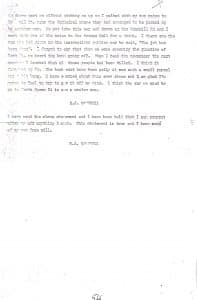
12. An example of the black propaganda circulated about McGurk’s
The document below is a log sheet produced by Kitson’s 39 Brigade. It read as follows:
RUC have a line that the bomb in the pub was bomb designed to be used elsewhere, left in the pub to be picked up by Provisional IRA. Bomb went off and was a mistake. RUC press office have line on it-NI should deal with them.

For more details about the circulation of disinformation about the bombing see: The McGurk’s Bar cover-up. Heath’s Faustian pact. How a British prime minister covered up a UVF massacre in the hope of acquiring Unionist votes to enable the UK join the European Economic Community, the forerunner of the EU.
Frank Kitson is still alive. These pages are open to him should he wish to provide his account of these events.
It is time for a judicial tribunal to look at this sordid affair and attempt to salvage the truth from the thick haze of lies that has engulfed this tragedy. By far the most intriguing file that could be surrendered to a tribunal would be the one that drove the MoD to go to such extraordinary lengths to readact three or four words from a log from 1971.
By far the most intriguing file that could be surrendered to a tribunal would be the one that drove the MoD to go to such extraordinary lengths to readact three or four words from a log from 1971.
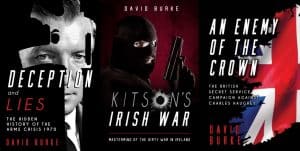
David Burke is the author of Kitson’s Irish War, Mastermind of the Dirty War in Ireland which examines the role of counter-insurgency dirty tricks in Northern Ireland in the early 1970s. His new book, An Enemy of the Crown, the British Secret Service Campaign against Charles Haughey, was published on 30 September 2022. Both books can be purchased here:
https://www.mercierpress.ie/irish-books/kitson-s-irish-war/
https://www.mercierpress.ie/irish-books/an-enemy-of-the-crown/
Other stories about British Intelligence black propaganda operations, dirty tricks, Bloody Sunday, the Ballymurphy massacre, Brigadier Frank Kitson and Col Derek Wilford on this website include the following:
From the vault: Sean Boyne’s 1972 profile of Brigadier Frank Kitson

